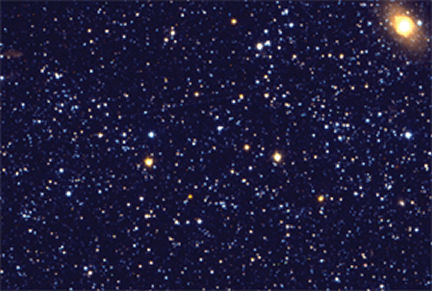It’s an extreme example of arrested development. The baby began growing normally but soon stopped, not to resume maturing until well into middle age. In this case, the late bloomer is a tiny galaxy called Leo A, which lies only 2.6 million light-years from Earth. Leo A appears to have retained features typical of much younger, more remote objects.

A new Hubble Space Telescope study of this wispy galaxy “has the potential to change the way astronomers build theoretical models for galaxy evolution,” says Andrew Cole of the University of Minnesota in Minneapolis. He and his colleagues describe their findings in the April 10 Astrophysical Journal Letters.
Before the instrument died, Hubble’s most sensitive visible-light detector, the Advanced Camera for Surveys (SN: 2/3/07, p. 68: Kaput: Hubble’s main camera stops working), observed Leo. Those data revealed that only 10 percent of all the stars in Leo A are ancient and that the rest didn’t begin igniting until 6.7 billion years after the Big Bang. That makes Leo unlike any other known nearby galaxy, says Cole.
Because of the scarcity of older stars, the dwarf galaxy must have been virtually dormant until 7 billion years ago. Moreover, unlike all other dwarfs that have been studied in detail, “Leo A has apparently never been at the mercy of the gravitational tug of much larger galaxies, such as our Milky Way, or the ionizing radiation of a large galaxy’s massive stars,” notes Cole.
That undisturbed life, as well as the galaxy’s proximity to Earth, makes Leo a good choice for astronomers for testing theories of galactic formation, he suggests.
Astronomers have little information about small, isolated galaxies. “We really don’t know how different Leo A might be from other isolated galaxies; it could be that the delay turns out to be a common feature,” Cole adds.
“Theoretical models for galaxy evolution aren’t yet at the stage of reliably predicting how galaxy properties should evolve as a function of mass and environment,” he says.
But Leo A poses a puzzle. After forming a few stars from its reservoir of gas early on, why did the galaxy take a rest for several billion years?
To coalesce into stars, galactic gas must be cold. The Hubble study shows that most of the hydrogen gas in Leo A is now warm and spread over the outskirts of the galaxy.
Cole suggests that the gas might have stayed warm for billions of years after being energized by some ancient cataclysm—perhaps a string of supernova explosions that erupted in the galaxy.
Because dwarf galaxies contain so little mass, star formation there can be easily quenched by heat or ultraviolet radiation, comments astronomer Mario Mateo of the University of Michigan in Ann Arbor. But it remains unclear what jolted this dwarf back into the star-making business 7 billion years ago, he adds.







